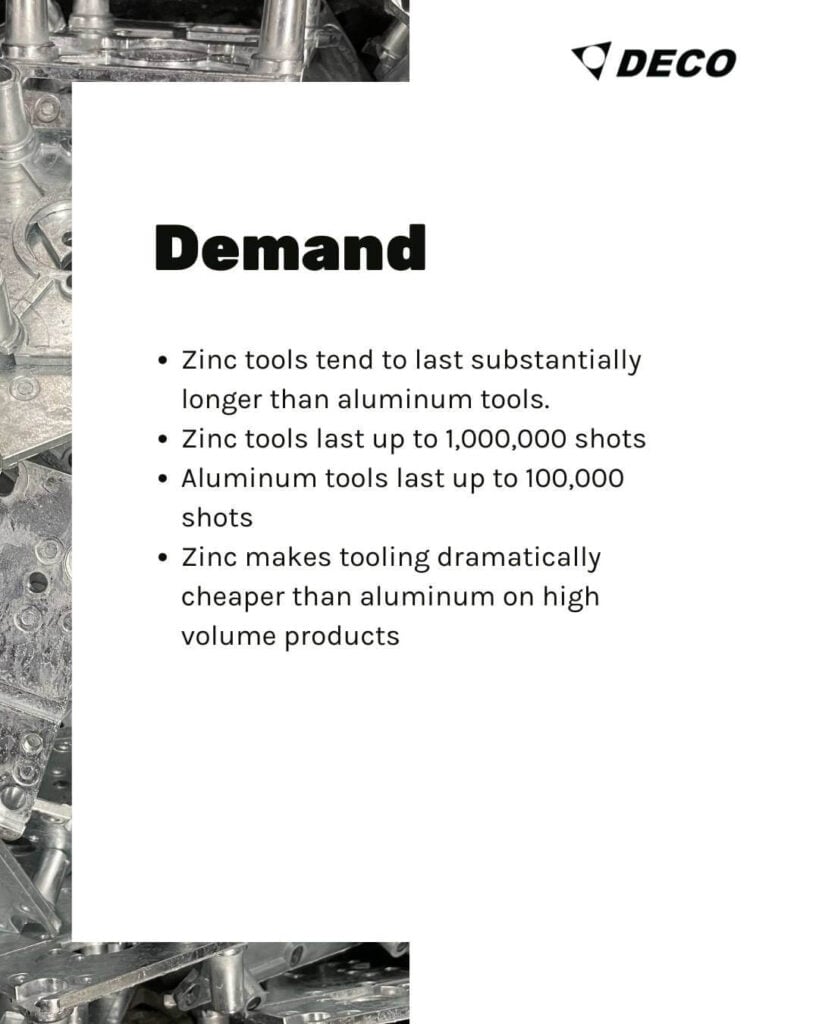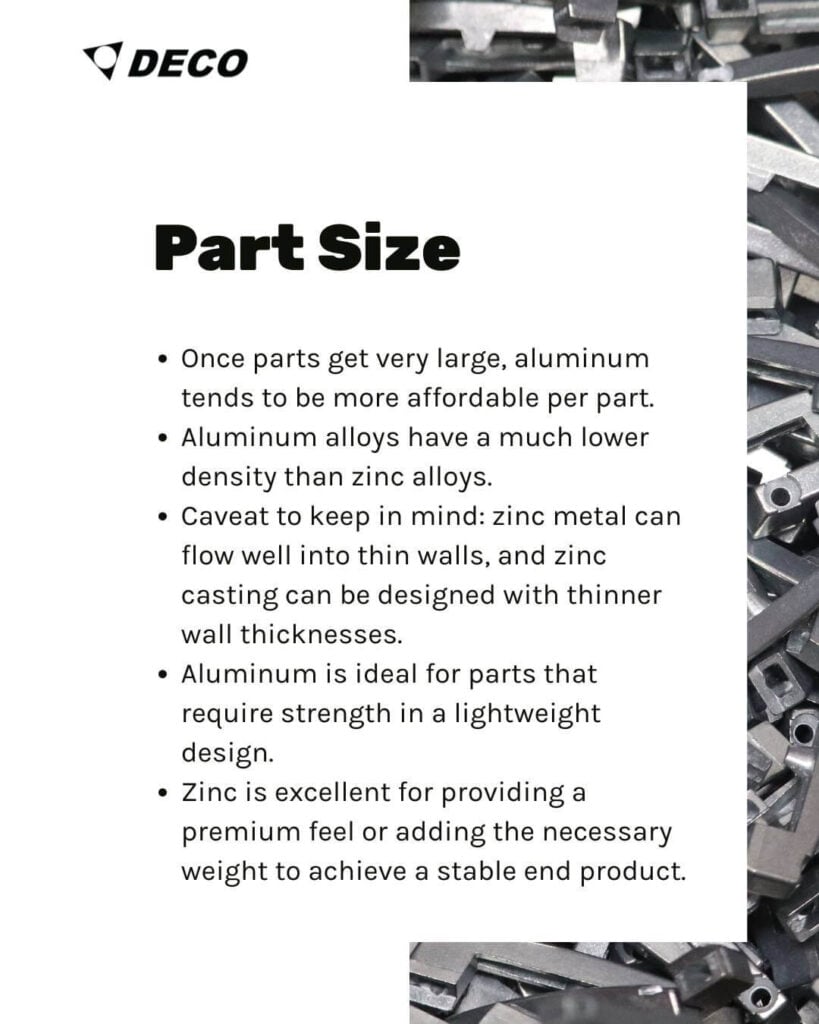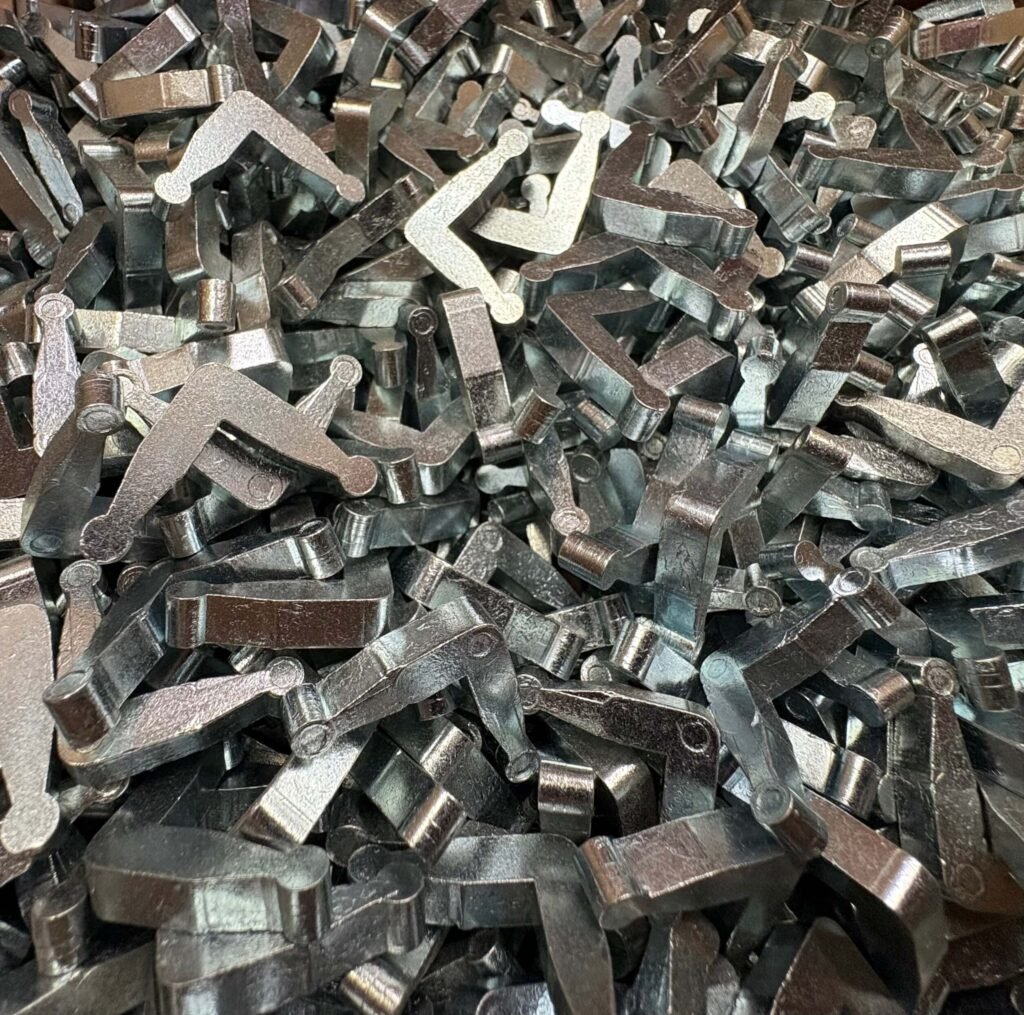Zinc die-casting is an elegant production process to solve a complex manufacturing problem: how do you make complex metal parts at a competitive cost?
When engineers are designing products, they must consider the use case of the product and identify which material solutions can fit that application. However, for many products, there are multiple manufacturing solutions that can solve the same function. For example, a part that may make sense to be a zinc casting could be made in any number of ways. If the material and manufacturing process are sufficient for the product needs, it quickly becomes a question of which method is most economical for the design and the volume.
Choosing Zinc Versus Aluminum
Zinc casting and aluminum casting are closely related processes. They are both based on high-pressure injection of molten alloy into a steel tool to fill a mold cavity and create a 3-dimensional part. Once the part has cooled, the casting is ejected from the tool and processed for sale.
Zinc and aluminum castings overlap in quite a few areas as they share very similar strength profiles. However, there are several technical aspects Engineers should consider when selecting a manufacturing method to optimize material costs. From a commercial perspective, there are two key considerations to keep in mind when selecting a metal: demand and part size.




Demand
Zinc tools tend to last substantially longer than aluminum tools. In many cases, we might expect a zinc tool to last 10x longer than an aluminum tool. For example, while one might expect an aluminum tool to last 100,000 shots, the same tool running zinc could last 1,000,000 shots or more. This makes zinc tooling dramatically cheaper than aluminum on high-volume products.
This tooling life is due to the physical properties of the metal. Aluminum requires high temperatures to melt. Compared to zinc alloy, aluminum alloy tends to be more abrasive as it flows through the tool into the cavity. As such, the key surfaces on the tool wear out faster on an aluminum tool than on a zinc tool.
Part Size
Once parts get very large, aluminum tends to be more affordable per part. Aluminum alloys have a much lower density than zinc alloys. If zinc alloys and aluminum alloys had the same price per pound, it would be more expensive to make the part out of zinc, as it requires more weight to fill the same cavity.
There are some caveats to keep in mind: as zinc metal can flow well into thin walls, zinc castings can be designed with a smaller wall thickness. Nevertheless, its useful to remember that all else being equal, zinc is more dense than aluminum.
In many cases, customers may also want to purchase products that have good strength per density. For example, the aerospace and automotive fields tend to prefer aluminum over zinc when considering adding strength without adding weight. On the contrary, some consumer appliance manufacturers prefer zinc over aluminum as it provides a premium feel or provides needed weight to control a stable end product.
Zinc vs Aluminum
Commercially, smaller high-volume parts tend to be good fits for zinc, whereas larger and lower volume parts tend to be good fits for aluminum.
There are also several technical considerations one might consider when selecting a zinc process versus an aluminum process, including tolerances, design flexibility, surface finish, impact strength, and more.
Zinc Die Castings vs Metal Stamping
Stamping is the process in which shapes are cut out off a sheet or coil of another raw material, most commonly steel. A cookie-cutter is a good analog for sheet metal stamping: you can use a form to quickly cut out a precise two-dimensional shape rapidly. Although stampings are fast, inexpensive, and frequently have short lead times, there are many reasons to select a casting versus a stamping.
More Design Freedom
Zinc casting allows for greater design flexibility and complexity. Stamping processes are typically limited to 2 dimensions. While there is additional metal forming or bending that can be integrated into the stamping process, the ability to make complex shapes is much easier with a casting process.

Although stamping is faster and cheap, and allows for construction of strong steel components, stamping imposes limitations on the shapes and forms that one can achieve. By comparison, zinc casting offers the ability to create intricate and detailed components with ease. This is particularly advantageous for industries that require unique and customized parts.
Consistent Part Quality
Zinc casting are uniquely good at providing dimensional accuracy and tight tolerances, ensuring that the final product meets precise specifications. While stamping can involve light variations or imperfections, zinc casting produces consistent and high-quality parts.
Less Assembly Work
Stampings can form complex 3d shapes through welding or assembly. However, castings are 3-diminesional out of the mold. As such, casting tends to be a much better choice when a complex shape is needed.
Better Material Use
Although stamping can be highly efficient at utilizing material, there will always be some material waste in a stamping process. Going back to the cookie-cutter analogy, there will always be some material left behind between the good shapes that were cut out.
At face value, zinc has the same problem — each part has a sprue and runner that are essentially excess material that will not be used in the final product. However, a casting can have that materially immediately recycled and re-cast. As such, zinc is nearly 100% recyclable and unused material can be immediately salvaged at the point of use.
Zinc Casting vs Injection Molded Plastics
Plastic injection molding is a similar concept to zinc die-casting. In both applications, the manufacturing material is heated to a liquid so it can flow under pressure into a cavity. Once the liquid material has flowed into the cavity, it can cool and harden, forming the shape of the desired product.
Although plastic injection molding can produce much cheaper parts, zinc offers distinct advantages in a wide variety of circumstances, such as strength, rigidity, durability, and dimensional stability.
Strong Parts That Last
Zinc allows for robust components that can withstand harsh conditions and heavy loads. Unlike plastic, zinc is completely resistant to ultra-violet rays, weathering, and stress-cracking in the presence of various reagents. In contrast, injection molded plastics may be more susceptible to wear and tear, especially in high-stress applications.
Parts Stay True to Size
Zinc castings cool and solidify in a rigid way. This controlled cooling gives excellent stability in size and dimensions. The final product keeps its shape and size specs after processing.
Zinc also experiences much less warping and heat-shrink as the hot casting cools. This allows engineers to confidently design tooling to make the final product fit the correct dimensions and tolerances.

Better Heat Resistance
Zinc castings excel in high temp uses. These die casting alloys reach melting temps 2-3 times higher than typical industrial plastics. Zinc is also an outstanding heat sync, meaning it has a tremendous capacity to absorb heat without the same risk of thermal expansion common in plastic components. Parts requiring some level of heat resilience are much better to be a metal casting than plastic.
Superior Finish
Decorative metal components that need durable finishes favor zinc die castings. Top surface traits allow powder coating, plating, painting, and chromating with little prep. The flexibility of being able to powder coat zinc castings allows for virtually any color match, whereas formulating plastic with an exact color without altering physical properties or shrink rate can be more challenging. Conversely, plastic parts are also more prone to warping and surface defects due to uneven cooling.
Superior Feel
Many customers in consumer applications associate weight with quality, where a light part feels cheap and flimsy compared to a heavier part. The high density of zinc alloy conveys the look and feel of strength and quality that plastic parts cannot match. Often times, this association is no just coincidental: the premium supplier selected a cast metal instead of plastic as it was going to perform better but at a higher cost.
Choosing the Right Process and Material
Engineers have to make many considerations when selecting a manufacturing process and material. First of all, there are the technical needs of the product. This includes strength, dimensional tolerance, dimensional stability, warp, and finish quality. There is also the important issue of commercial concerns: which material and process will produce the necessary quality and performance at the best total cost?
Zinc casting are frequently compelling choices for Engineers looking for the right balance of cost and quality. While zinc castings may not be the lowest price, they may be the best value. The benefits of zinc alloy often translate into reduced production costs and improved product performance.
Engineers designing precision components should look at hot chamber die-castings early in their development process. You can contact us here to help you review your design for overall manufacturability and cost savings ideas.

